Final report for FW16-023
Project Information
Our project was aimed at researching and providing additional means for farmers markets on the Big Island to increase sales of local foods. Our planned methodology included visits to eighteen markets collecting data from farmers market managers and local food vendors, collating it and then producing educational materials to benefit producers and consumers. We discovered that conventional data collection methods were inappropriate, many vendors mostly wanted to 'talk story' with us in depth about the range of issues that they confronted in their efforts to make a basic living as farmers and marketing at farmers markets. We have honored these 'experts' by adapting our outcomes and our reporting to include their varied contributions which we consider to be the most valuable and relevant to the intended project outcome.
The USDA and farmers’ market advocates believe that direct marketing provides agricultural producers with improved profit-making opportunities and a venue for selling producers extra produce. Advocates also assert EBT and senior farmers’ market programs put more fresh fruits and vegetables into low-income diets. The Resources for Farmers’ Markets website asserts, "Farmers markets provide communities with fresh, nutritious, affordable, and local farm products and enable farmers to increase profits by selling directly to consumers who enjoy the opportunity to buy high-quality, fresh products directly from the farmers at competitive prices." The Hawaii Homegrown website states that "farmers markets are a main driver of our local food economy." Another prominent local writer states "farmers markets are the heart of our island’s local, sustainable food system.” Our submitted project proposal originally accepted these basic assumptions regarding farmers markets as fact but as a result of our research the validity of these claims needs to be questioned and many of them are found to be myths.
Other generally accepted benefits that farmers markets offer include providing the perfect entry place for developing a product line for other retail or wholesale venues, fostering community and food linkages, bringing neighbors together, helping children to learn where their food comes from, allowing consumers to talk directly with the farmers and ranchers who grow their food plus promoting community development and tourism. These additional assumptions were also studied and are described here in more detail with our research results determining them as general truths in the case of Big Island farmers markets.
The term 'farmers market' is used for approximately 25 venues on Hawai'i Island. The number of vendors at each of these markets ranges from 5 to 200. Some serve neighborhoods, others serve whole districts and each is unique.
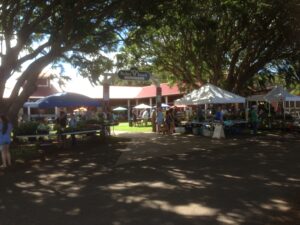
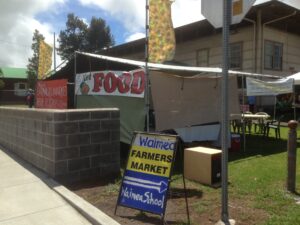
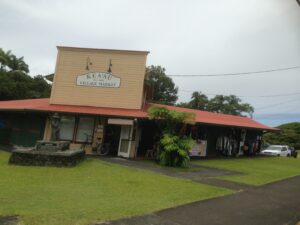
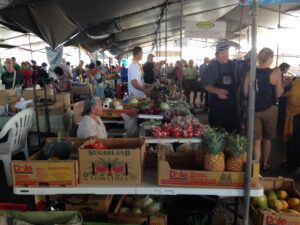
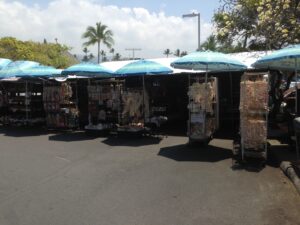
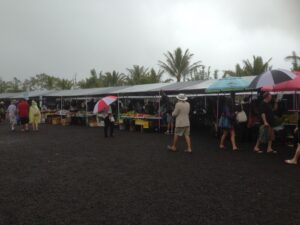
The variety of fresh produce and food products is dazzling.
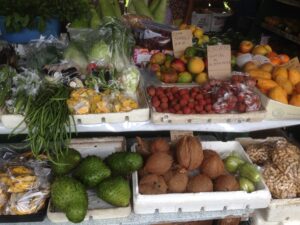
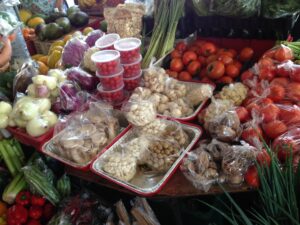
Many food crops and products are grown conventionally, but more vendors are offering certified organic produce and value added products.
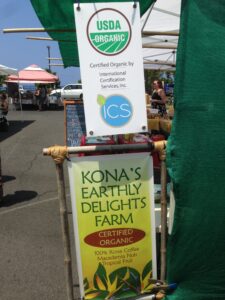


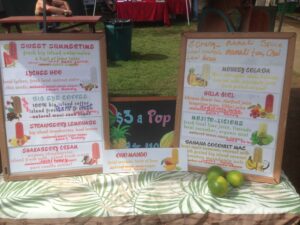
Many markets have plants and flowers. Some markets add arts, crafts, clothing and miscellaneous household items, new and used. Many markets include the sale of foods not grown on the Big Island.
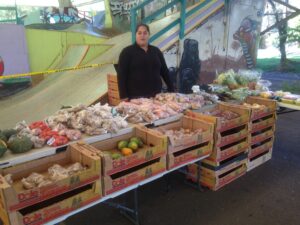

Our research concluded that seldom do farmers markets provide substantial profit-making opportunities for producers of local foods and they seldom function as significant venues for selling producers 'extra' produce. Most long term producers selling local foods at farmers markets are small family farms motivated by both profit making opportunities and a commitment to the other benefits that farmers markets provide.
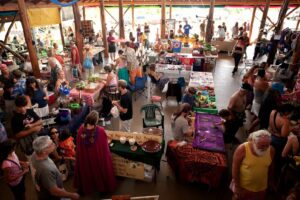
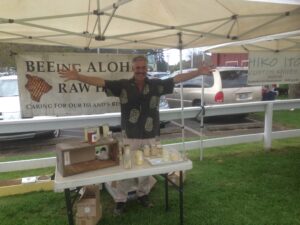
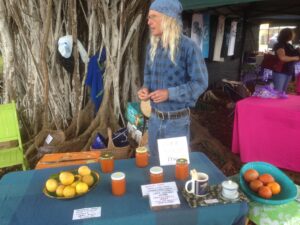

Big Island farmers markets contribute very little overall to EBT and senior farmers’ market programs aimed to put more fresh fruits and vegetables into low-income diets. The major reason is that the high quality, fresh, nutritious local farm products they provide communities are generally not sold at prices competitive with supermarkets and health food stores. Where prices are competitive the local food producer is often not generating a 'profitable business' but struggling to maintain a resilient family farm operation.
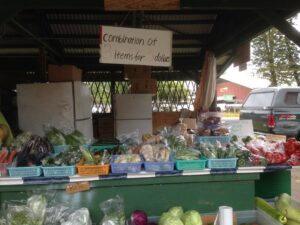
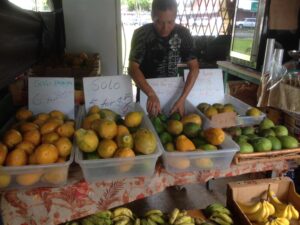
Contrary to the desires and dreams of advocates farmers markets are not a main driver of our 'local' food economy and are sadly not "the heart of our island’s local, sustainable food system."
The Big Island, like the whole country, has experienced a rapid growth in the establishment of farmers markets in the last fifteen years but there has been a wide range of expressions and most fall far short of the classic definition of "a market where local farmers and growers sell their produce directly to the public." Sales of imported foods and food products, arts and crafts, prepared foods, used household items and non food items totally dwarf the income earned by producers of local foods at all the markets, but two, of those we researched. While most of the eighteen farmers markets visited are considered 'sustaining' and three are 'thriving' there are at least four that have experienced severe declines and will probably close down in the near future.
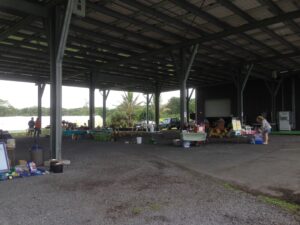
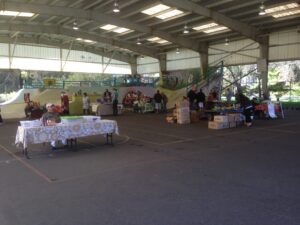
A number of local government reports and plans point to the need to increase local food production but farmers are highly critical of the lack of action to implement this goal. Building a local food system is not easy. Consumers must demand locally sourced products, communities must work together to establish the infrastructure needed to support a local system, and farmers must be supported to work with distributors, consumers and each other. There is consensus among the farmers we interviewed that the local government focus still remains with supporting larger commercial farm operations and not local family farms.
Discovering the most profitable way to sell a product can be a serious challenge for busy farmers and ranchers. With increasing demand for local food, today’s producers are finding innovative ways to access new and existing markets. Farmers Market producers in Hawaii often sell their products directly to consumers,restaurants, retail stores,community supported agriculture (CSA) or online.
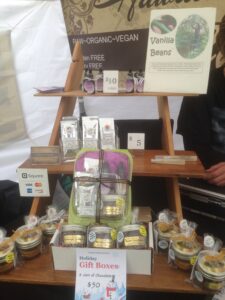
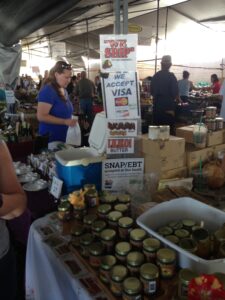
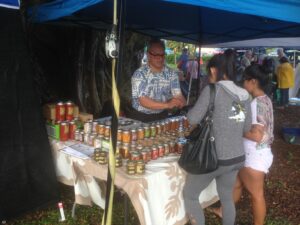
They can also use an intermediary or middleman, such as cooperatives, retailers, restaurants and more recently schools, to help them distribute their produce locally. We discovered that as a risk management strategy, Big Island farmers and ranchers often use multiple sales channels.
Part of marketing is advertising the product and setting the brand apart from competitors. Many of the local farmers we interviewed have done this by sharing their farm story, which provides a personal touch for consumers, who are generally far removed from food production, to satisfy their desire to know the origin of what they eat.

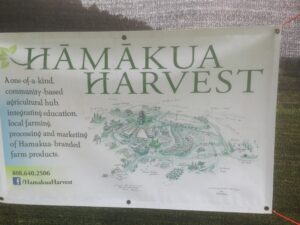
Increasingly, Big Island farmers are realizing that they can earn extra income by selling value-added products both crops and animals by processing them to increase their value. Knowing that customers are willing to pay more for finished products farmers are slowly engaging in overcoming the legalities and complexities of producing and marketing them. Our research discovered a wide range of amazingly creative results and the growing trend for increased sales to tourists and off island consumers via the internet. This is undoubtedly a direction that will continue to develop and produce more income for local farmers but some claim that is taking resources away from the sales of locally produced fresh produce to local residents at farmers markets.
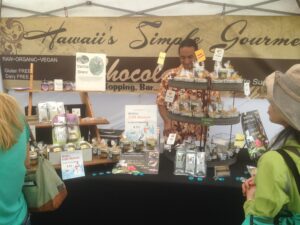
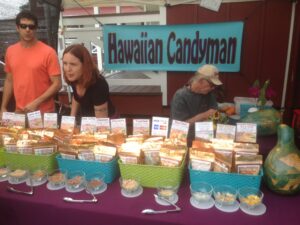
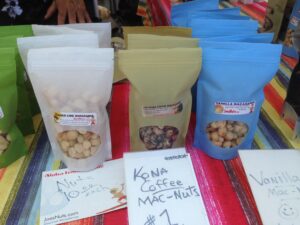
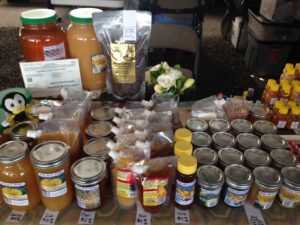
Big-Island-Diet-Farmers-Market-Listing-Handout
Big-Island-Diet-Farmers-Market-Support-Organizations-Handout
Big-Island-Diet-Farmers-Market-Produce-List-Handout
Big-Island-Diet-Farmers-Market-Value-Added-List-Handout
Big-Island-Diet-Farmers-Market-Vendor-List-Handout
- Conduct pilot market research at four market days at the Real Farm stand at Kamuela Farmers Market surveying consumers on their purchase history of existing and potential farm produced foods and value added products.
- Create a producer survey and visit eighteen farmers markets around the island. Collect data from producers / retailers at the 18 markets of all the farm products and value added products offered to consumers.
- Research value added products legal requirements, recipe suggestions, processing facility options and marketing options.
- Compile a list of 12 island residents who consume high percentages of local foods. Submit a draft article and request media writers and editors to include articles about these local folks in their publications to promote a Big Island Diet.
- Create a handout listing of locally produced foods and value added products currently available at Hawaii Island farmers markets.
- Provide a handout with contact information of organizations supporting farmers market activities and value added products support with legal requirements, processing facility options and marketing options.
- Encourage the creation of a Big Island Farmers market managers network.
- Create recipes that primarily use local foods with descriptions of how to prepare and serve local food items.
- Create a handout listing locally grown foods sold seasonally at the 18 Hawaii Island farmers markets.
- Create an updated handout listing Big Island Farmers markets with location and opening times and distribute it to local news media sources.
- Support farmers markets with efforts to establish Supplemental Nutrition Assistance Program (SNAP) services for their customers.
- Complete Report writing requirements for SARE.
Cooperators
- (Researcher)
- - Technical Advisor (Educator and Researcher)
- (Educator)
Research
Prior and during our research phase we had 9 meetings with staff from the Kohala Center, the Hawaii Island Food Alliance and the local Farmers Union who are knowledgeable regarding district agriculture and local food related programs. We established communications to prevent duplicating the work of any similar projects currently in process and agreed to share information as this project proceeded. These organizations and others have been valuable collaborators in our research phase. They have their own additional distribution networks that will help facilitate getting our educational materials into the hands of producers and market vendors upon completion of our project.
We found that our farmers market research visits took much longer than we had anticipated since many farm produce vendors had detailed stories they wanted to share. These anecdotal stories contributed a great deal to the conclusions made from our research. We discovered that some vendors were quite wary about answering questions asked by anyone carrying clipboards and so sometimes we had to modify our data collection approach in order to gain their trust and to convince them that we were not 'investigating' them.
The research of value added products legal requirements was accomplished through our attendance at an excellent workshop organized by the Small Business Development Center of Hawaii. We not only learned about legal requirements and marketing but also contact information for further assistance which we have been able to share with vendors. We obtained a list of commercial food processing facilities from the Kohala Center and from our vendors surveys. We collected local food recipes from many sources and also researched Hawaii recipe and diet books which sadly lacked any focus on the primary or absolute use of local ingredients. This is a development that is worthy of future lobbying of cook book writers and publishers.
Impacts
We discovered that efforts to reverse 200 years of social, political, and economic policies in order to create systemic change and re-localize the food system in Hawaii is extremely challenging. Many grassroots organizations are working hard and making progress with the limited amount of funding they are able to obtain through grant writing and local fundraising but what’s required is a more serious commitment by local government. Unless the State and County budgets provide increased funding and new laws supporting local food system development the necessary structural changes are impossible to implement.
An example of this is the North Kohala Eat Locally campaign which in 2008 adopted a community goal to produce 50% of the food eaten by North Kohala residents by 2018 establishing a community-based strategic plan and several initiatives to help accomplish that goal. With only a 5% level reached by 2012, a lack of funding and little government support the main organizer eventually left the project and the campaign has lost all momentum.
Another finding from our project that explains the dismal success of eat local campaigns is that it is a myth that direct marketing at farmers markets has made local foods more 'affordable' for consumers. The demographics of market customers which comprise of mostly middle class residents and tourists plus the very levels of Supplemental Nutrition Assistance Program sales proves that lower income residents have not been attracted to farmers markets by cheaper prices and other benefits and still prefer the prices and convenience offered by supermarkets.
Our research in Hawaii confirmed the results of a case study in California which compared marketing costs of three farms selling by wholesale, CSA, and farmers market farmers and concluded that profits are less when selling at farmers markets. The three farms studied were well-established, diversified organic growers one small (20 acres, 2 full-time employees); one medium (70 acres, 7 employees); and one larger (240 acres, 30 employees). Across all three, labor was the highest marketing expense. For the small farm, labor was 77 percent of all marketing costs, ranging from 67 percent in wholesale to 82 percent for farmers markets. Farmers markets generated the lowest net revenue return for all three growers, while wholesale provided the highest net return for all. The study points out that price premiums at farmers markets are not pure profit. (Hardesty, 2008).
Most farmers/producers in our study did not keep accurate records but those who took the time to calculate their costs of production, marketing and labor confirmed this conclusion. The motivation for most farmers market local foods vendors includes benefits other than maximizing profits from sales of local produce.
Most Hawaii Island farmers markets offer a reliable, flexible outlet where vendors can sell a wide range of fresh produce, plants, honey, value-added products like jams or breads and even (depending on local health regulations) meats, eggs and cheeses. For beginning direct marketers, farmers markets can be a great place to start, to test new products, to network with other growers and with potential customers. Most of these vendors also have a strong commitment to serving their local community, meeting with old friends and believe in the principles of direct marketing and the development of local food networks.
Additional results from our research is that there are major benefits to be obtained from the establishment of regular meetings and communications opportunities between farmers market managers. Presently these experts have a wealth of knowledge and no means to share it with others doing the same work and sharing the same vision. Fortunately the Kohala Center has taken on the task of moving towards the creation of this network.
Sadly, only seven of the eighteen markets visited offered Supplemental Nutrition Assistance Program purchase options which reduces the likelihood that lower income residents will attend. An added outcome of this SARE project was that our project staff successfully wrote and processed a grant application to get the Kamuela Farmers Market approved as an EBT/SNAP benefits location. On January 20th 2018 the market initiated the EBT/SNAP program with the aid of volunteers and it has been running successfully ever since with an increase in purchases weekly.
Accomplishments
- We conducted intensive market research surveying consumers on their purchase history of existing and potential farm produced foods and value added products during four market days at Kamuela Farmers Marke
- We interviewed and collected data from 64 producers / retailers at 18 markets regarding their experiences with farmers markets and the farm products and value added products they offered to consumers.
- We researched value added products legal requirements, recipe suggestions, processing facility options and marketing options and shared this information with producers as we visited markets.
- We surveyed 12 island residents who consume high percentages of local foods then wrote a draft article which we submitted to media writers and editors requesting them to include articles about these local folks in their publications to promote a Big Island Diet.
- We created a listing of locally produced foods and value added products currently available at Hawaii Island farmers markets.
- We provided a contact list of organizations supporting farmers market activities and value added products support with legal requirements, processing facility options and marketing options and distributed it to producers.
- We met with other organizations to encourage the creation of a Big Island Farmers market managers network.
- We created recipes that primarily use local foods with descriptions of how to prepare and serve local food items.
- We created a list of locally grown foods sold seasonally at the 18 Hawaii Island farmers markets.
- We created an updated list of Big Island Farmers markets with location and opening times and distributed it to five local news media sources.
- We wrote a successful grant that enabled the Kamuela Farmers Markets to establish a Supplemental Nutrition Assistance Program (SNAP) for their customers. The program started 1/20/18.
Research Outcomes
Education and Outreach
Participation Summary:
Big-Island-Diet-Farmers-Market-Listing-Handout
Big-Island-Diet-Farmers-Market-Support-Organizations-Handout
Big-Island-Diet-Farmers-Market-Produce-List-Handout
Big-Island-Diet-Farmers-Market-Value-Added-List-Handout
Big-Island-Diet-Farmers-Market-Vendor-List-Handout
In addition to the educational materials listed above (also linked on the project results page) which are self explanatory we were also engaged in the following outreach activities:-
We were able to motivate value added producers to join in the common cause of increasing their lobbying efforts for laws that protect homemade food operations. (defined as an enterprise that produces in a home or farm kitchen that conforms to the building code of the county preparing allowable foods for sale to the public.)
In order to mitigate the challenges facing value added food producers in Hawai‘i while protecting public health we managed to share information verbally about proposals for a new legal framework for homemade food operations in Hawai‘i. We discovered that producers are adamant that laws applicable to homemade food operations should be totally separate from temporary food establishments.
With respect to leasing certified kitchen space, we discovered a severe lack of certified kitchens available for rent by value added producers in Hawai‘i, especially in rural areas. For example, Hawai‘i Island’s Puna and Kona Districts lack any certified For the few certified community kitchens that are available, use of these facilities is unfeasible for many producers. Hourly rental rates quickly become cost prohibitive for small food businesses, especially for those who make foods with long processing times, such as dried fruit. In addition, many community kitchens have limited equipment and insufficient space for storage and refrigeration, which restricts the types and quantities of products that may be produced. Low population density in rural areas often means that certified community kitchens, if available, are many miles away. With gas prices in Hawai‘i being the highest in the nation, traveling long distances can be cost prohibitive for small businesses. In the absence of government funding for building new commercial kitchen facilities we discussed with vendors a strategy to lobby elected officials for rental subsidies for producers to promote the expansion of value added products.
Through consultations with farmers we have identified 12 island residents who consume high percentages of local foods and who will participate in our future Big Island Diet article. We've contacted these residents and they have all completed a survey that we designed providing information about how to live on a high percentage local diet. Two media sources so far have expressed interest in including this article and have scheduled it for future publications. We recommend that these valuable resource people are encouraged to share their knowledge and enthusiasm about local diets in other ways reaching and motivating more residents.
We have attended three quarterly meetings of the Hawaii Island Food Alliance and have made presentations at two meetings. We recommend any parties involved in local food production or distribution to join this group and attend their meetings
We were told by all the meat vendors that the Big Island is in great need of a mobile slaughter house to facilitate the processing of locally grown beef, lamb, pig and goat. This is another development requiring co-ordinated lobbying of elected officials and Dept. of Agriculture staff which could be led by the Hawaii Island Food Alliance as it grows in influence and membership.
The Big Island Dept. of Health has recently added rules requiring all farm eggs to be constantly refrigerated at farmers markets if they have been previously refrigerated on the farm. We encouraged vendors to work together to share fridge facilities and collectively find solutions to this new bureaucratic hurdle.
We discovered that there is a seasonal excess of citrus fruit produced on small farms that is presently not sold at farmers markets. We connected several fruit producers with fresh juice value added producers to create an outlet for future sales of this excess.
We shared information with farmers that value added vendors expressed a need for more local tumeric, organic ginger, cilantro and vinegar.
We learned from the Hamakua Agricultural Co-op that a shortage of start up capital is a major hindrance to new members. They have the lease for about 1000 acres of land until 2033 and have unused seven acre parcels of land for new members but few applicants. The main obstacle for local residents, especially those of Philipino ancestry seems to be the challenge of creating acceptable business plans. This needs to be brought to the attention of the Dept. of Agriculture who could reduce these bureaucratic barriers or give more assistance to small farmers.
Education and Outreach Outcomes
Homemade food operations (defined as an enterprise that produces in a home or farm kitchen that conforms to the building code of the county in which the kitchen is located allowable foods for sale to the public.)
In order to mitigate the challenges facing value added food producers in Hawai‘i while protecting public health we propose lobbying for a new legal framework for homemade food operations in Hawai‘i. Laws applicable to homemade food operations should be totally separate from temporary food establishments.
Value Added Products With respect to leasing certified kitchen space, there are very few certified kitchens available for rent in Hawai‘i, especially in rural areas. For example, Hawai‘i Island’s Puna and Kona Districts lack any certified For the few certified community kitchens that are available, use of these facilities is unfeasible for many producers. Hourly rental rates quickly become cost prohibitive for small food businesses, especially for those who make foods with long processing times, such as dried fruit. In addition, many community kitchens have limited equipment and insufficient space for storage and refrigeration, which restricts the types and quantities of products that may be produced. Low population density in rural areas often means that certified community kitchens, if available, are many miles away. With gas prices in Hawai‘i being the highest in the nation, traveling long distances can be cost prohibitive for small businesses. In the absence of government funding for building new commercial kitchen facilities we propose that subsidies be provide to producers to promote the expansion of value added products.
Local Food Diets Through consultations with farmers we have identified 12 island residents who consume high percentages of local foods and who will participate in our future Big Island Diet article. We've contacted these residents and they have all completed a survey that we designed providing information about how to live on a high percentage local diet. Two media sources so far have expressed interest in including this article and have scheduled it for future publications. We recommend that these valuable resource people are encouraged to share their knowledge and enthusiasm about local diets in other ways reaching and motivating more residents.
Networking. We have attended three quarterly meetings of the Hawaii Island Food Alliance and have made presentations at two meetings. We recommend any parties involved in local food production or distribution to join this group and attend their meetings